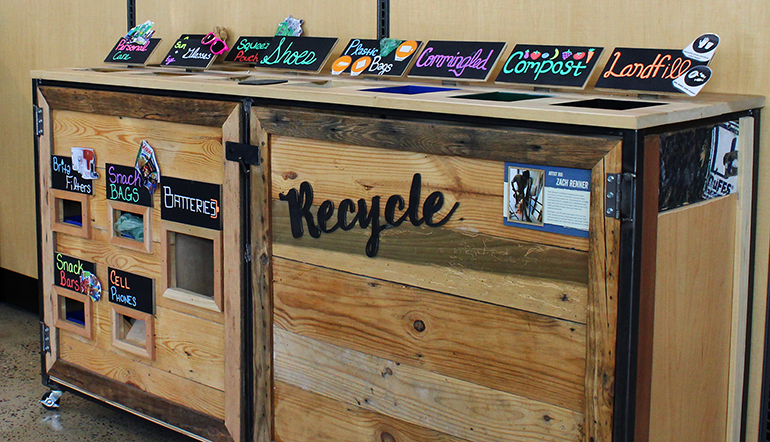Recycling rules are different everywhere, and the rules can be constantly changing. Some states and counties collect certain items, whereas others will not take it. For example, in my hometown, Fairfax, Virginia, the county does not take glass items in single stream recycling. This is because glass is heavy and it costs more to transport it. This leads to issues with recycling further down the line, because there is a surplus of glass items that have nowhere to go. For this blog entry, I decided to talk about a company located in my hometown, called “MOM’s Organic Market”. I chose this business because I worked there for about a year, and I was involved in investigating and restoring environmental issues. Their purpose is to protect and restore the environment and one of the ways they do this is through a recycling program called the “Recycle Center”.
The idea was created by an individual who worked for the company and it has been implemented in every single one of their stores across the east coast. The Recycling Center is a wooden container with different labeled compartments that correspond with unique types of recyclable items. Since being implemented, MOM’s has recycled hundreds of tons of compost, holiday lights, natural cork, and more. A unique aspect of the company is that some locations accept items that their corresponding counties do not accept. For example, the Alexandria, Virginia location participated in a drive with The Purple Glass Bin Project. This organization collects and crushes glass (which turns to sand and gravel) in Northern Virginia, as many counties in Northern Virginia do not accept glass. Together, they recycled 822,520 pounds of glass and raised awareness throughout the state on this issue.

How the Recycling Center works is: you enter any of the locations along the east coast and ask where the Center is located in the store. There is no charge whatsoever to drop off recyclable goods, and you do not have to be a customer to drop off items. You then toss whatever items are recyclable, and you leave! It’s as easy as that. If you have questions about recycling, all of the employees are knowledgeable on the topic and can locate a place or organization that would take particular items. One item they do not accept is plastic grocery bags, because most places in Northern Virginia that do accept them as recycling tend to incinerate the bags, causing greenhouse gas emissions in the atmosphere. The company does not “greenwash” their sustainability goals, as the entire purpose of the business is to protect and restore the environment. The owner and founder of MOM’s is named Scott Nash and he made the business as a grocery store to pay for the real mission, which is fixing the state of the environment. The company does not provide plastic bags to customers, and they also only use solar and wind power for energy sources. This company is truly a “green” business that gives back to the planet, and their employees.
Sources:
“Glass.” Fairfax County Virginia, https://www.fairfaxcounty.gov/publicworks/recycling-trash/glass.
Hamstra, Mark. “Mom’s Organic Market Evolves as It Expands to 19th Location.” Supermarket News, 5 June 2018, www.supermarketnews.com/organic-natural/mom-s-organic-market-evolves-it-expands-19th-location.
“Our Purpose Is to Protect and Restore the Environment.” MOM’s Organic Market, https://momsorganicmarket.com/ourpurpose/.







